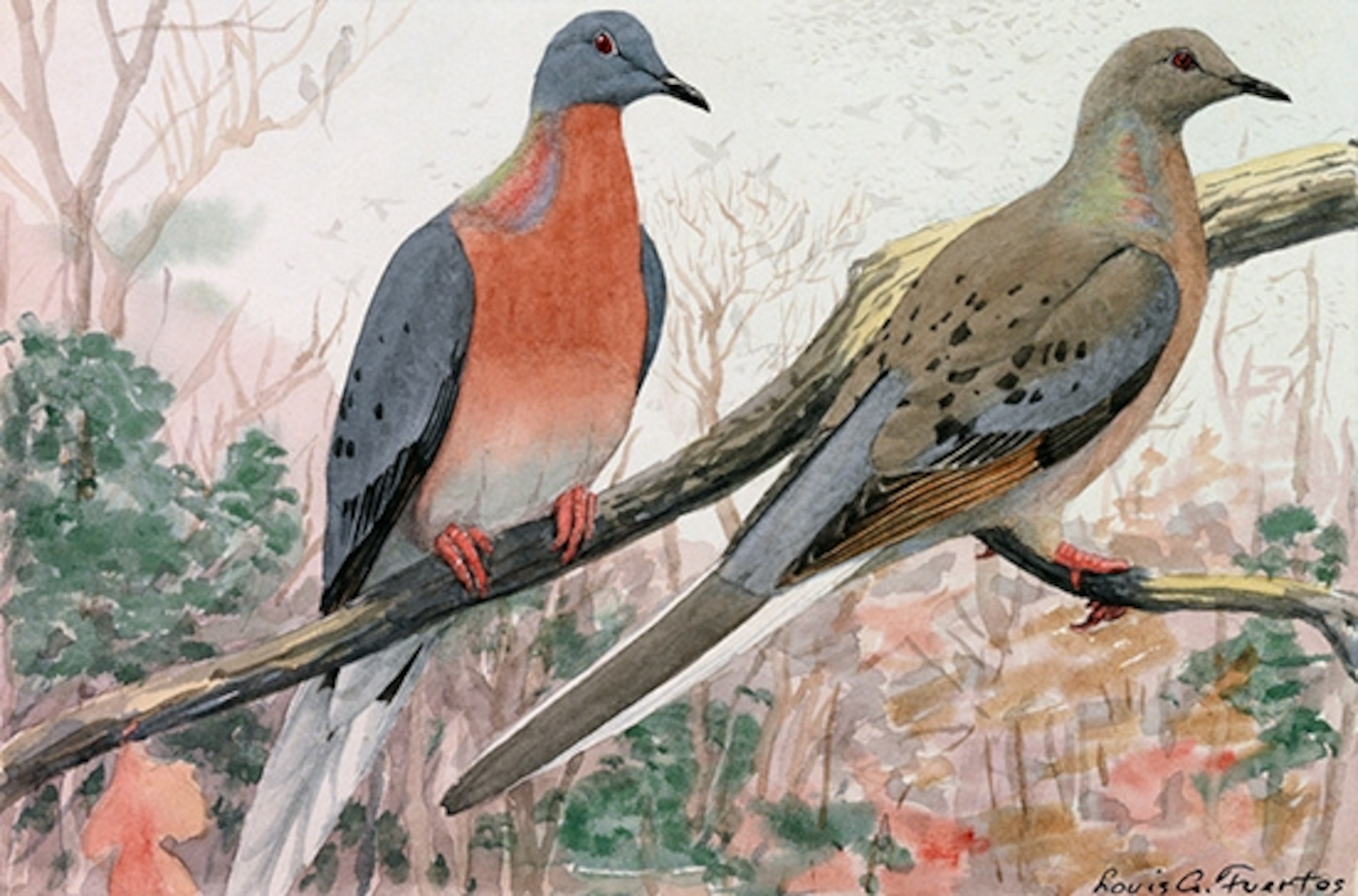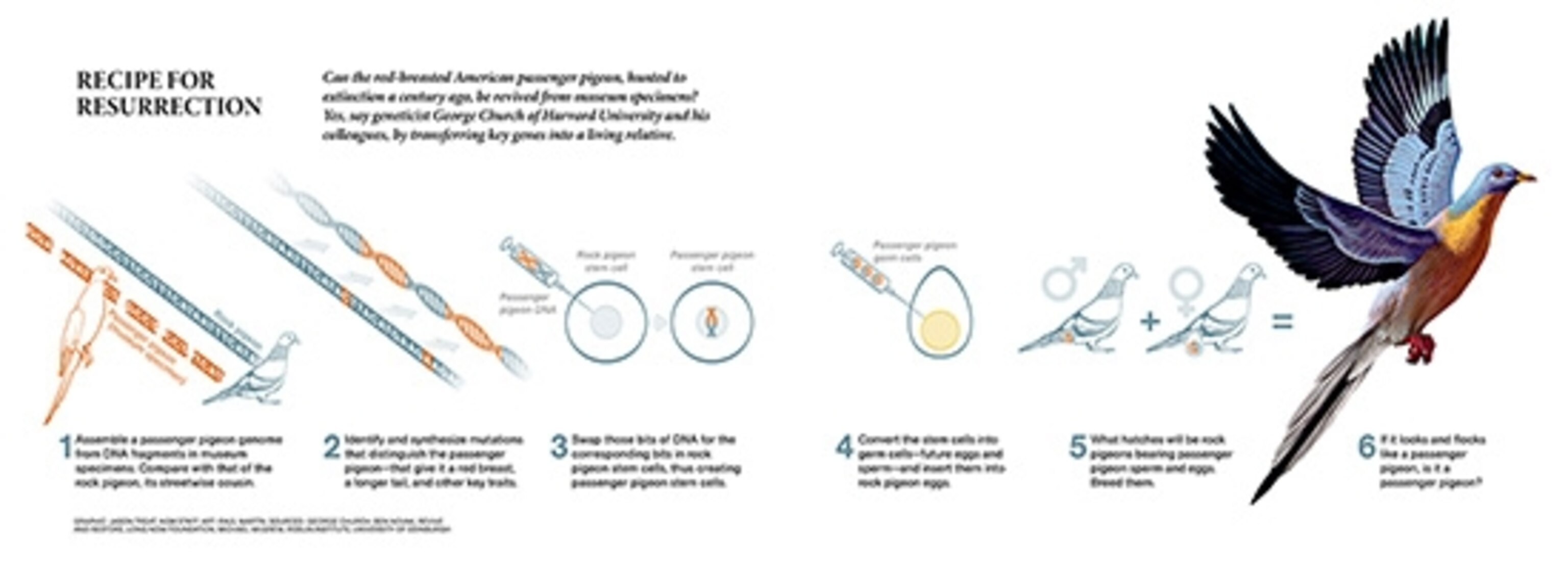In the early 1800s, a naturalist named Alexander Wilson was traveling in Kentucky when the sky suddenly became dark. Wilson believed, he later wrote, that it was “a tornado, about to overwhelm the house and everything round in destruction.”
When Wilson got his wits back, he realized the sun had been blotted out by passenger pigeons.
The journals of many early explorers contain similar passages. The passenger pigeon would sweep across the eastern United States in vast flocks, feeding on chestnuts and acorns as they traveled. As Wilson gazed at his passenger pigeon flock, he tried to figure out how many birds it contained. From one side to the other, it was a mile wide. It streamed overhead like a feathered river for more than four hours. Based on that information, Wilson guessed that it contained over 2.2 billion birds–“an almost inconceivable multitude,” he wrote, “and yet probably far below the actual amount.”
In 1914, the passenger pigeon became extinct, likely thanks to industrial-scale hunting. In his book Nature’s Ghosts, Mark Barrow notes that our eradication of such a populous species came as a tremendous shock–one that helped the world appreciate nature’s true fragility.
Because the passenger pigeon disappeared before modern ecology came of age, scientists don’t know much about its natural history. They’ve had to rely mostly on the reports of witnesses like Wilson–reports that encourage us to leap to a fairly simple story: vast flocks of passenger pigeons, followed by a few stuffed corpses preserved in museum.
But in recent decades, some researchers have argued that the history of passenger pigeons was more complicated. In 1985, for example, the archaeologist William Neumann pointed out that Native American archaeological sites don’t contain many passenger pigeon bones. If the birds were blot-out-the-sun abundant for thousands of years, you’d expect Native Americans to have feasted on them. Neumann argued that the nineteenth-century swarms did not reflect the long-term reality of passenger pigeons.
Now a new generation of scientists are tackling this question with a new line of evidence: DNA. It turns out that some stuffed pigeons stored in museum collections still retain some decent-sized chunks of genetic material.
In this week’s Proceedings of the National Academy of Sciences, Chih-Ming Hung of National Taiwan Normal University and colleagues report how they got DNA from the toe pads of three passenger pigeons–two caught in Minnesota and one in Pennsylvania. They managed to get anywhere from 57 to 75% of the entire genome of each bird.

When scientists can study that much DNA from an animal, they can learn a lot of things from it. They can learn, for example, how big the population of its ancestors was in the past.
Scientists can manage this feat thanks to the variation in each animal’s genes. If you compare a collagen gene in your DNA to someone else’s, the two copies may be a little different. That’s because mutations arose in the gene as it was passed down through the generations.
In a big population, there will be a lot of these variants, which will get passed down to future generations. A small population, on the other hand, doesn’t have the necessary size to contain many variants. The individuals in that population will pass down their meager genetic variation to their offspring.
The genetic variation in a population today can thus serve as a clue to its size in the past. Even if it later swells up to huge proportions, it may still only have a small amount of variation, because its origins were so modest.
Strictly speaking, scientists can’t measure the true size of an ancient population this way. Only a fraction of individuals in each generation end up reproducing, and so we can only look at the variation of their genes. Scientists refer to this smaller group of reproducers as the “effective population size.” It’s useful to know the effective population size, however, because it can serve as a rough guide to a true population. (Typically, the effective population size is about a tenth of the true population.)
When scientists first began to measure effective population sizes, they would do so by comparing a particular gene in a lot of individuals. In recent years, they invented a neat reverse trick: they can now estimate the effective population size by looking at a lot of genes from just a few individuals. If many of those genes are different from one individual to another, their difference tells scientists that those animals came from a big population in the past. If the genes are very similar, the population was small.
What’s especially remarkable about this method is that it lets scientists track the size of a population through time. That’s because scientists can compare how long ago the variants of each gene arose from a common ancestor. If a lot of gene variants can be traced back to one particular time, that suggests the population was small then. In 2011, Heng Li and Richard Durbin of the Wellcome Trust Sanger Institute used this method to reconstruct human history from just six genomes. They found that human populations shrank drastically between about 50,000 and 20,000 years ago, and then expanded tremendously.
Now Hung and colleagues have used the same method to track passenger pigeon population. Surprisingly, they found that the long-term average effective population size was only 330,000 birds. Scientists have estimated that the population of passenger pigeons in the nineteenth century was between 3 and 5 billion birds. In other words, the effective population size is a thousand times lower than you’d expect.
This mismatch hints that passenger pigeons had a much smaller population at some point in the past. And when Hung and colleagues reconstructed the history of the passenger pigeon population, they found that the birds have indeed gone through some huge fluctuations. About 120,000 years ago, the pigeons were abundant, but they shrank to a small population 21,000 years ago. They then rebounded after the last Ice Age, reaching another peak about 9000 years ago. Since then, they have been declining slowly.
This pattern fits the ecological history of the Ice Ages pretty well. About 120,000 years ago, the climate was warm, glaciers were at their minimum, and forests were widespread across North America. By 21,000 years ago, a lot of passenger pigeon territory was covered by ice, and much of the remaining habitat couldn’t support the oak and chestnut forests that the birds depended on for their food. Once the glaciers retreated, the forests returned, along with the birds.
But Hung and colleagues argue that these long-term climate changes are only part of the explanation for the small effective population size of passenger pigeons. They propose that the birds were like locusts, swiftly expanding when food supplies were good, but collapsing when times got bad. (Real locusts can reach 100 billion in an outbreak, but their effective population size is only half a million.)
In their new study, Hung and colleagues come to a similar conclusion to Neumann’s. The huge flocks that naturalists like Wilson saw in the nineteenth century were not an immutable fixture of the pre-industrial American landscape. Instead, Wilson may have simply been witness to an outbreak of birds.
It’s even possible that settlers from Europe may have been responsible for that outbreak. Native Americans may have kept pigeon populations low by hunting them and collecting acorns and chestnuts. By pushing Native Americans off their land, the Europeans may have allowed the birds to increase their numbers–and helped them even more by planting crops that the birds could feed on.
As researchers assemble passenger pigeon DNA, they also move closer to potentially bringing the bird back from extinction. As I described last year in National Geographic, they could theoretically use the genome of a closely related species, the band-tailed pigeon, as a scaffolding to engineer DNA with passenger-pigeon-specific mutations. Ben Novak of the University of California at Santa Cruz explained in this TEDx video how it might then be possible to breed birds with this DNA until they looked–and perhaps even behaved–like passenger pigeons of old.

Hung’s new study (and similar research being carried out by Novak and his colleagues) suggests that scientists might be able to get passenger pigeons back on their feet without creating the billion-strong flocks that Wilson saw. Even though they sometimes fell to far smaller numbers, passenger pigeons survived for hundreds of thousands of years before people started firing guns at them.
On the other hand, if we were to bring the passenger pigeon back from extinction, it may not stay at some steady population level. If the conditions were right, it might explode to higher numbers. And if we make life difficult for the birds–through climate change, for example–it’s possible that we could drive their numbers down again. The passenger pigeon may be able to do a good impression of a tornado, but it’s still delicately dependent on its ecosystem.
[Apologies for the typos in the original version of this post. I hope I’ve caught them all now.]

